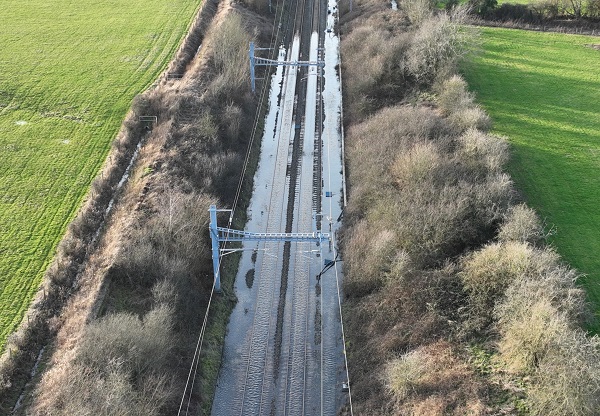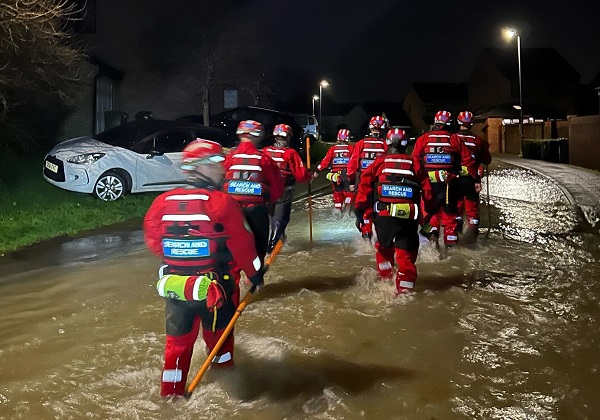COUNCIL leaders say they have learned important lessons from floods which forced 100 families out of their homes.
But one resident who was forced out of his home for five months says the authority has glossed over the impact on people whose homes were damaged – while another questioned whether works at Chipping Sodbury railway tunnel, where the flood originated, will actually stop it happening again.
The floods hit Slimbridge Close and Littledean, off Shire Way, and swamped parked cars during Storm Bert last November.
The railway running south of the town flooded with a torrent of water flowing off an embankment, overwhelming drains and entering into nearby houses.
Because of the severity of the floods, South Gloucestershire Council investigated what exactly happened and how to prevent similar problems.
That investigation was published ahead of a cabinet meeting in July, when councillors praised the community response.
Liberal Democrat Councillor Louise Harris, cabinet member for climate, said: “We had huge support from the community and from the local pub.
“It was a horrendous incident but the community did really pull together. Network Rail have obviously got a lot in here relating to them and are carrying out work at the moment. That emergency work is already happening.”
Council staff who knocked on over 200 doors on the night, and on following days, to see what support was needed were praised.
An evacuation centre was prepared at Yate Leisure Centre but this ultimately wasn’t used as people stayed with friends and families.
But one criticism in the investigation was a lack of communication following the floods.
Lessons learned from the council’s response to the floods led to a change in approach to the gas explosion in April on Lancaster Road in Yate, which also saw a huge amount of support from the local community.
Yate councillor and cabinet member Chris Willmore said: “One of the lessons we learned is just how overwhelmingly generous the community is, and how we have to build that into our planning for these crises, so that they’re able to do something to help.
“If there are any lessons you think we could learn from these processes, it’s important you keep telling us.”
Report ‘glosses over’ residents’ suffering
Resident David Butcher, who with his young family was forced to live away from their home for five months, criticised the investigation for glossing over the impact on people whose homes were damaged.
He said: “While I am pleased to see a report which has many forward-thinking suggestions and proposals, I feel the huge personal impacts throughout the past six months — both financial and emotional — have been completely bypassed within the report.
“My home was significantly damaged, with flooding through the entirety of the ground floor.”
Another resident, Nicola Blaken, said: “My young family were forced to relocate for six months while repairs works were carried out.
“Are there any reassurances from Network Rail that their prevention works will be finished to cope with this possibility? Is there any evidence to show that these works will help prevent future flooding?”
Water flowed down from the railway, which runs along a cutting south of the town, and into residential roads.
A mile and half east of the affected houses, the railway runs through the Chipping Sodbury tunnel which frequently floods.

This causes the main line to close several times a year. But last autumn was wetter than normal, so the rain was falling on already saturated ground. And 60% of the rain that fell in November came in just one weekend, overwhelming drains.
The railway’s gradient falls from east to west, so water flowed down the track, acting as a channel.
Network Rail have been carrying out extensive work on this section of the railway, in an attempt to prevent similar floods happening again in future.
Drainage channels were inspected and cleared, and one of four pumps that removes water from the railway has been replaced.
Report ‘doesn’t go far enough’
However, Conservative councillor Nic Labuschagne said the recommended actions for the council are just “business as usual”.
He said: “The recommendations don’t seem to be going far enough or are really in any way ambitious. It’s an insufficient response to the scale of Storm Bert. This fails to address the clear evidence that the systems were overwhelmed.”
The Environment Agency says 4,633 homes in the district are at high risk of surface water flooding, with 4,207 at medium risk, and a further 5,783 at risk of river or sea flooding.
Households at risk are advised to prepare a flood plan with emergency contact numbers and evacuation routes, door barriers and air brick covers as well as a “grab bag” of essentials like medication, a torch, phone charger, bottled water and snacks.
By Alex Seabrook, Local Democracy Reporting Service


